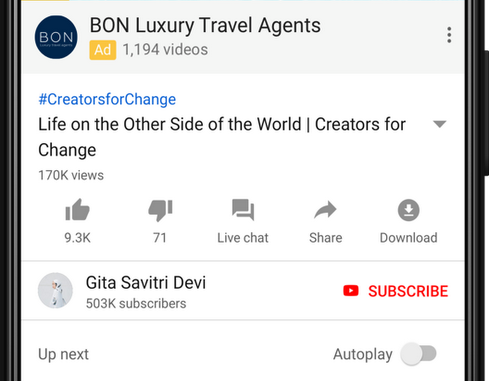
At YouTube, we’re on a constant quest to give people the perfect viewing experience. But over the years, what that looks like has changed significantly.The way we watch video is always changing. And we want to keep advertisers abreast of these trends, with new ad experiences molded to the new ways people watch. This was the spirit behind our introduction of six-second bumper ads more than two years ago–as a response to the increasingly mobile habits of our users.Today we’re highlighting how we’re adapting to three new trends in the user experience.Longer viewing sessionsOur recent user experience research suggests that in addition to factors such as the length of ads, viewers are quite sensitive to the frequency of ad breaks, especially during longer viewing sessions. Through this research, we also learned that fewer interruptions is correlated with better user metrics, including less abandonment of content and higher rates of ad viewing. To respond to this, we will begin testing ad pods–two ads stacked back to back, where viewers have the option to skip directly to the content if it’s not the right ad for them.Why does this solution make sense? Because when users see two ads in a break, they’re less likely to be interrupted by ads later. In fact, those users will experience up to 40 percent fewer interruptions by ads in the session.1 Early experiment results also show an 8-11 percent increase in unique reach and a 5-10 percent increase in frequency for advertisers, with no impact to Brand Lift metrics.2 This new experience, launching on desktop this year then followed by mobile and TV screens, aims to accommodate viewer preferences while continuing to help advertisers connect with their most important audiences.Example of an ad pod experience on mobile.More self-directed discoveryThe way users prefer to find videos to watch is also changing. Remember back when the only YouTube videos you’d watch came in the form of a shared URL from a friend? Over the years, video viewing on YouTube has become more self-directed, as more viewers than ever before hop into their home or trending feeds and scroll to find a recommended video. In fact, over the last three years, watch time from content users discover on the YouTube homepage has grown 10X.3 That’s why we brought TrueView video discovery ads to the YouTube home feed, along with the Masthead and Universal App campaign ads. The YouTube home feed continues to be a great place for users to discover their next favorite creator, and now it can be a great place for them to discover your brand.Watching on TV screensWe’re seeing incredible watchtime growth on TV screens: on average, users watch over 180 million hours of YouTube on TV screens every day.4 Last month, we introduced the TV screen device type in Google Ads and Display & Video 360, allowing you to tailor your campaigns for connected TVs – for example, by using a different creative or setting a specific device bid adjustment – and see reporting for ads that run on TV screens.In the face of these burgeoning user trends—as well as the next wave, and the next—we’ll continue working to build the ideal video viewing experience, and keep thinking up ways to deliver value for our advertiser partners.1. YouTube Internal Data, Global, October 20182. YouTube Internal Data, Global, October 20183. YouTube Internal Data, Global, Jan 2015 vs. Jan 20184. Google Internal Data, Global, June 2018. Based on 7 day average for TV watchtime
Source: Google Inside Adwords
Link: How evolving user patterns drive new ad experiences on YouTube



Leave a Reply